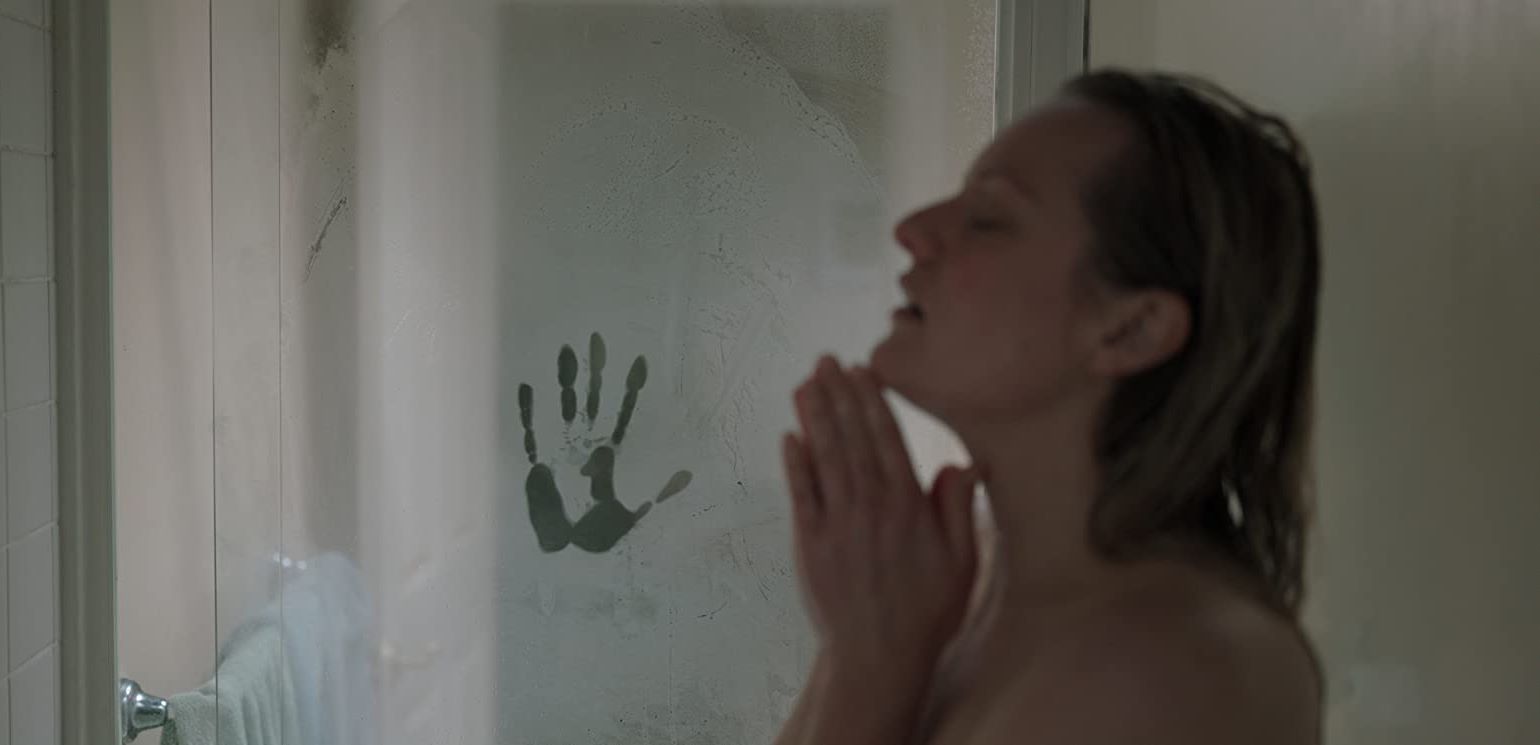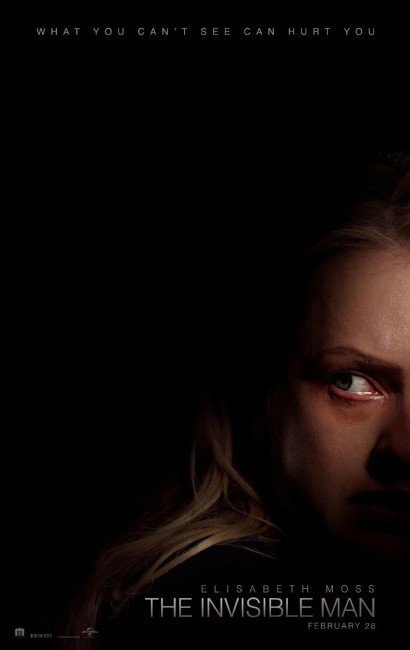USA. 2020.
Crew
Director/Screenplay – Leigh Whannell, Producers – Jason Blum & Kylie Du Fresne, Photography – Stefan Duscio, Music – Benjamin Wallfisch, Visual Effects Supervisor – Jonathan Dearing, Special Effects Supervisor – Dan Oliver, Production Design – Alex Holmes. Production Company – Blumhouse Productions/Goalpost/Nervous Tick Productions.
Cast
Elisabeth Moss (Cecilia Kass), Aldis Hodge (James Lanier), Harriet Dyer (Emily Cass), Storm Reid (Sidney Lanier), Michael Dorman (Tom Griffin), Oliver Jackson-Cohen (Adrian Griffin)
Plot
Cecilia Kass makes an escape from her boyfriend Adrian Griffin, a tech billionaire specialising in optics, who has been very controlling of her. She goes to stay with her police officer friend James Lanier, keeping her whereabouts a secret from Adrian. Some weeks later, she receives news that Adrian has committed suicide. Adrian’s brother Tom, a lawyer, reveals that Adrian has left a five million dollar bequeathment to her in his will. In the weeks after, Cecilia is certain that Adrian is still haunting her. He had always promised he would return invisibly and she now believes he is doing small things to torment her. Soon this invisible harassment begins to destroy her life and causes her sanity to fray as she is certain that the invisible Adrian is creating divides with all the people in her life.
The Invisible Man (1897) was one of the key science-fiction works from H.G. Wells. The book was adapted by James Whale into the film The Invisible Man (1933) starring Claude Rains in the title role. This was one of Whale’s best films, an hilariously droll comedy with some exceptional effects work for the era. Universal then spun the character off in a series of sequels with The Invisible Man Returns (1940), The Invisible Woman (1940), Invisible Agent (1942) and The Invisible Man’s Revenge (1944), before the inevitable Abbott and Costello Meet the Invisible Man (1951).
There have been several other obscure versions of the Wells – a Turkish version in 1955, a Russian version in 1984 and the six-part, period-set BBC mini-series The Invisible Man (1984), which is the most faithful to the book of all the adaptations, and the subsequent Fear the Invisible Man (2023) – while the character also turns up as one of The League of Extraordinary Gentlemen (2003). There have also been several tv series that borrow the title but nothing else with The Invisible Man (1958), The Invisible Man (1975) and The Invisible Man (2000-2), which are simply about the exploits of various invisible heroes. In the 1980s, the invisible man theme has gravitated to B movies like the tawdry The Invisible Maniac (1990) or became the basis of comedies like The Man Who Wasn’t There (1983), The Invisible Kid (1988) and Invisible Mom (1995), even The Erotic Misadventures of the Invisible Man (2003). More recent years have seen it revisited with CGI effects in Memoirs of an Invisible Man (1992), Hollow Man (2000) and The Unseen (2016). (For a more detailed listing see Films About Invisibility).
The Invisible Man was originally announced as one of the films in Universal’s Dark Universe, which was part of a plan to imitate the Marvel Cinematic Universe using the Universal Famous Monsters of the 1930s and 40s – Dracula, the Frankenstein monster, the Wolf Man, The Mummy and the Invisible Man. However, the films that emerged – Dracula Untold (2014) and The Mummy (2017) – ended up being uninspired efforts that everybody hated. After the flop of the latter, Universal decided to abandon their Dark Universe. Enter Blumhouse who picked up the rights to remake The Invisible Man. Blumhouse have been responsible for a host of medium-budget horror films throughout the 2010s with the likes of Paranormal Activity (2007), Insidious (2010), The Purge (2013) and Happy Death Day (2017), which they have all been spun out into successful series, along with a host of other films. (See bottom of the page for Blumhouse’s other films).

The film emerges under Leigh Whannell who first appeared as co-writer and co-star of Saw (2004). He and good friend James Wan then went on to make Dead Silence (2007), Insidious (2010) and Insidious Chapter 2 (2013) with Wan directing and Whannell co-writing and co-starring. Whannell also wrote Cooties (2014) and The Mule (2014) for others and has made a number of acting appearances in films. Whannell made his directorial debut on Insidious Chapter 3 (2015) and then went on to make Upgrade (2018), a clever little A.I. film that was produced by Blumhouse. Subsequent to this, Whannell went on to conduct another Famous Monsters remake with Wolf Man (2025).
The Invisible Man emerges as an oddity to say the least. It is important to see it in the context of the way that Blumhouse do business. There is the insistence that most of their films be made on budgets of five million dollars or less. They will sometimes exceed this – and The Invisible Man was given a $7 million budget. On the other hand, one balks at this as they sit down to watch the film, thinking it is near impossible to produce the requisite CGI effects on that kind of budget.
The Invisible Man we get is a film that it has almost nothing to do with the H.G. Wells novel, the 1933 film or any of the sequels to it. There is a scientist named Griffin who creates a means of becoming invisible – which was a formula for Wells and becomes a light reflective suit here. In both cases, the invisible man is a disturbed figure – although for Wells, this was something brought on as a side effect of the formula whereas here he is a controlling and domineering personality from the outset. There end differences. For Wells, the Invisible Man was reduced to poverty and trying to get enough money to get by, whereas here he is a tech billionaire. In the book, the Invisible Man was the subject of a police manhunt, whereas in the film the police doubt his existence and think it is all in the heroine’s head. For the film, the Invisible Man is not even the central character – more of a nemesis that pops up to harass and gaslight the heroine.

The strangeness of The Invisible Man is that it is nothing that you expect of an invisible man film. As a kid, I used to love the David McCallum series and would draw illustrations of invisible people lifting objects. That is the essential appeal of invisibility films – of watching the effects show on display or the weird possibilities of objects levitating and appearing to move on their own. However, here almost all of the things that an invisibility film rests upon – the effects – have been curtailed. It is I suspect Leigh Whannell having had to reconceive The Invisible Man as a medium budget Blumhouse film.
There is the very occasional thing – a nicely subtle scene where Elisabeth Moss stands on a porch on a cool evening and there comes a puff of misty breath from behind her. Mostly the film is visual effects free – physical effects like footprints on a carpet, a blanket pulled off the bed, Elisabeth Moss pretending to wrestle with an invisible man on the kitchen floor. The latter half gives us slightly more digital effects – scenes of a partially visible invisibility suit and with jail guards being thrown around and shot by levitated guns. However, there is surprisingly little of this and in terms of delivering the one thing you expect of an invisibility film – novelty invisibility effects – The Invisible Man must be regarded as a disappointment.
For all that the film calls itself The Invisible Man, all the focus is on a woman Elisabeth Moss. In fact, what we have is less an invisible man film and more a thriller like Sleeping with the Enemy (1991) and Enough (2002) about women trying to escape abusive spouses who continue to stalk them with fanatically controlling and psychopathic regard. The bulk of The Invisible Man has been reconceived as a work about a woman’s flight from an abuser and his continuing to stalk her. Here we have an invisibility man film that is not about showcasing novelty effects but merely putting the invisibility to the ends of his gaslighting Elisabeth Moss and making people think she is going insane.
Jason Blum and his Blumhouse production company have produced a number of other genre films including:- Hamlet (2000), Paranormal Activity (2007) and sequels, Insidious (2010) and sequels, Tooth Fairy (2010), The Bay (2012), The Lords of Salem (2012), The River (tv series, 2012), Sinister (2012) and sequel, Dark Skies (2013), Oculus (2013), The Purge (2013) and sequels, the tv mini-series Ascension (2014), Creep (2014), Jessabelle (2014), Mercy (2014), Mockingbird (2014), Not Safe for Work (2014), Ouija (2014) and sequel, 13 Sins (2014), The Town That Dreaded Sundown (2014), Unfriended/Cybernatural (2014), Area 51 (2015), The Boy Next Door (2015), Curve (2015), The Gallows (2015), The Gift (2015), Jem and the Holograms (2015), The Lazarus Effect (2015), Martyrs (2015), Visions (2015), The Visit (2015), The Darkness (2016), Hush (2016), Incarnate (2016), The Veil (2016), Viral (2016), Amityville: The Awakening (2017), Get Out (2017), Happy Death Day (2017), The Keeping Hours (2017), Split (2017), Stephanie (2017), Bloodline (2018), Cam (2018), Delirium (2018), Family Blood (2018), Halloween (2018), Seven in Heaven (2018), Truth or Dare (2018), Upgrade (2018), Black Christmas (2019), Ma (2019), Prey (2019), Don’t Let Go (2019), Sweetheart (2019), Black Box (2020), The Craft: Legacy (2020), Evil Eye (2020), Fantasy Island (2020), Freaky (2020), The Hunt (2020), Nocturne (2020), You Should Have Left (2020), Black As Night (2021), The Black Phone (2021), Dashcam (2021), Firestarter (2022), M3gan (2022), Mr Harrigan’s Phone (2022), Nanny (2022), Soft & Quiet (2022), Run Sweetheart Run (2022), Sick (2022), They/Them (2022), Torn Hearts (2022), The Visitor (2022), Unhuman (2022), The Exorcist: Believer (2023), Five Nights at Freddy’s (2023), There’s Something Wrong With the Children (2023), Totally Killer (2023), Unseen (2023), Afraid (2024), Imaginary (2024), Night Swim (2024), Speak No Evil (2024), Wolf Man (2025) and The Woman in the Yard (2025).
Trailer here


